Services on Demand
Journal
Article
Indicators
-
 Cited by SciELO
Cited by SciELO -
 Access statistics
Access statistics
Related links
-
 Cited by Google
Cited by Google -
 Similars in
SciELO
Similars in
SciELO -
 Similars in Google
Similars in Google
Share
CT&F - Ciencia, Tecnología y Futuro
Print version ISSN 0122-5383
C.T.F Cienc. Tecnol. Futuro vol.6 no.3 Bucaramanga Jan./June 2016
COMPARISON OF CRUDE OIL SOURCE-RELATED INDICATORS BASED ON C15-, Cl5+ AND C40+ PARAMETERS.
COMPARACIÓN DE INDICADORES DE FUENTE DE CRUDOS BASADOS EN PARÁMETROS DE C15-, C15+ YC40+.
COMPARAÇÃO DE INDICADORES DE FONTE DE ÓLEOS CRUSEM PARÂMETROS DE C15-, C1S+ YC40+.
Liliana López1* and Salvador Lo Mónaco-Trupiano1.
1 Instituto de Ciencias de la Tierra, Facultad de Ciencias, Universidad Central de Venezuela, Caracas, Venezuela.
e-mail: addresses: liliana.lopez@ciens.ucv.ve.
How to cite: López, L. & Lo Mónaco , S. (2016). Comparison of crude oil source-related indicators based on C15-, C15+ and C40+ parameters. CT&F - Ciencia, Tecnología y Futuro, 6(3), 53-70.
* To whom correspondence should be addressed.
(Received: Oct. 15, 2015; Accepted: Apr. 27, 2016).
ABSTRACT.
This work presents a comparative study of source-related indicators based on parameters determined in the C15-, C15+ and C40+ fractions in oil from the Barinas sub-basin, Venezuela. The objective was to determine whether the results obtained from High Temperature Gas Chromatography (HTGC-C40+) for the definition of organic facies and maturity, along with obtained by Whole-Oil Gas Chromatography (WOGC-C15+), to define maturity and secondary processes at the reservoirs are comparable with those obtained from biomarkers (GCMS-C15+). WOGC detected the presence of n-C5 to n-C9 alkanes, benzene and toluene, and the lack of these components indicates water washing. Oils from Caipe, La Victoria, Silvan, and Guafita not show biodegradation or water washing; Sinco show water washing and La Victoria and some from Guafita and Silvan oils presented evidence of evaporative fractionation. Biomarkers indicates that the oils derived from marine, algal and bacterial organic matter with variation in terrigenous organic matter input generated by a mature source rock with different lithofacies (siliciclastic-carbonatic). Based on CPI0 (C42-C46) five oils have values > 1, which is associated with marine depositional environments. However, 21 samples have  , which considered typical of freshwater lacustrine environments, which differs from those determined in previous works based on biomarkers and isotopic studies.
, which considered typical of freshwater lacustrine environments, which differs from those determined in previous works based on biomarkers and isotopic studies.
Keywords: Biomarkers, Organic facies, Sedimentation environment, Gas chromatography, Marine deposits, Crude oils.
RESUMEN.
Este trabajo presenta un estudio comparativo de indicadores de fuente basados en el estudio de parámetros determinados en las fracciones C15-, C15+ y C40+ en crudos de la sub-cuenca de Barinas, Venezuela. El objetivo fue determinar si los resultados obtenidos a partir de cromatografía de alta temperatura (CGAT-C40+) para la definición de facies orgánicas y madurez, ¡unto con los de cromatografía de crudo total (CGCT-C15-,), para definir madurez y procesos secundarios en el yacimiento son comparables con los obtenidos de biomarcadores (CGEM-C15+). CGCT detectó alcanos entre n-C5 a n-C9, benceno y tolueno, y la ausencia de estos compuestos indicó lavado por aguas. Los crudos de Caipe, La Victoria, Silvan y Guafita no presentan biodegradación o lavado por aguas, Sinco presenta lavado por aguas y La Victoria, y algunos de Guafita y Silvan presentan fraccionamiento evaporativo. Los biomarcadores indicaron un origen de materia orgánica marina, algal y bacterial; con variaciones en el aporte de materia orgánica terrígena, en una roca fuente madura con distintas facies litológicas (siliciclásticas-carbonáticas). Basado en CPIa (C42-C46), cinco crudos tienen valores > 1, asociado a ambientes de sedimentación marinos. Sin embargo, veintiún (21) crudos tienen  , relacionado a ambientes lacustres de aguas dulces, lo que difiere de estudios previos basados en biomarcadores e isótopos.
, relacionado a ambientes lacustres de aguas dulces, lo que difiere de estudios previos basados en biomarcadores e isótopos.
Palabras clave: Biomarcadores, Facies orgánicas, Ambiente de sedimentación, Cromatografía de gases, Depósitos marinos, Crudos.
RESUMO.
Este trabalho apresenta um estudo comparativo de indicadores de fonte baseados na apreciação de parâmetros determinados nas frações C15+, C15+ e C40+ em crus da sub-bacia de Barinas, Venezuela. O objetivo foi determinar se os resultados obtidos com base na cromatografia de alta temperatura (CGAT-C40+) para a definição de fácies orgânicas e maturidade e processos secundários na jazida são comparáveis com aqueles obtidos pelo uso de biomarcadores (CGEM-G15+). CGCT possibilitou a detecção de alcanos entre n-C5 a n-C9, benzeno e tolueno, e a ausência destes compostos foi indicação de lavagem por águas. Os óleos de Caipe, La Victoria, Silvan e Guafita não apresentam biodegradação ou lavagem por águas, Sinco apresenta lavagem por águas e La Victoria, e alguns de Guafita e Silvan apresentam fracionamento evaporativo. Os biomarcadores indicaram uma origem de matéria orgânica marina, algal e bacteriana; com variações no aporte de matéria orgânica terrígena, em uma roca fonte madura com diferentes fácies litológicas (siliciclásticas-carbonáticas). Baseado no CPIa (C42-C46), cinco óleos crus têm valores > 1, sendo associados a ambientes de sedimentação marinhos. No entanto, vinte e um (21) óleos crus têm  associados a ambientes lacustres de águas doces, o que difere com os levantamentos prévios baseados em biomarcadores e isótopos.
associados a ambientes lacustres de águas doces, o que difere com os levantamentos prévios baseados em biomarcadores e isótopos.
Palavras-chave: Biomarcadores, Fácies orgânicas, Ambiente de sedimentação, Cromatografia de gáses, Depósitos marinhos, Óleos Crus.
1. INTRODUCTION.
Analysis of crude oils based on biomarkers (e.g. Peters & Moldowan, 1993; Hunt, 1996; Peters, Walters & Moldowan, 2005; Armstroff et al, 2006; Gaimes, Eglinton & Rullkõtter, 2009; Silvan, Datta & Singh, 2008; Aboglila et al, 2010; Nytoft, Kildahl-Andersen & Olukayode, 2010, El Diasty & Moldowan, 2012; Sinninghe Damsté, Schouten & Volkman, 2014; Wang, Chang, Wang & Simoneit, 2015; and reference therein), isotopic composition (Sofer, 1984a; 1984b; Aboglila et al, 2010) and trace elements such as V/Ni ratio (Al-Shahristani & Al-Thyia, 1972; López, Lo Monaco, Espinoza & Blanco, 1991; López et al, 1995; López, Lo Monaco & Richardson, 1998; Frankenberger et al, 1994; Alberdi, López & Galarraga, 1996; López & Lo Monaco, 2004, López & Lo Monaco, 2010) provides information about organic matter types, paleoenvironmental sedimentation conditions and maturity. Furthermore, biomarkers are used to determine the level of biodegradation of oils (Volkman et al., 1983a; Volkman, Alexander, Kagi & Woodhouse, 1983b; Volkman et al, 1984; Tissot & Welte, 1984; Peters & Moldowan, 1993; Hunt, 1996; Wenger, Davis & Isaksen, 2002; Huang, Bowler, Oldenburg & Larter, 2004; Larter et al, 2006; Bennett & Larter, 2008; Haeseler, Behar, Gamier & Chenet, 2010; Larter et al, 2012; Zhang et al, 2014). Other crude oil studies include the analysis of Low Molecular Weight Hydrocarbons (LMWHC: Cis-) by Whole Oil Gas Chromatography (WOGC) (Leythaeuser, Schaefer &Weiner, 1979;Philippi, 1981; Thompson, 1983; 1987; Odden, Patience & Van Graas, 1998; Odden, 1999; Odden & Barth, 2000; Jarvie, 2001; Cañipa-Moralesa, Galán-Vidal, Guzmán-Vega & Jarvie, 2003; Thompson, 2006; Hill et al, 2007). In this case, a set of relationships using compounds such as benzene, toluene, xylene, n-alkanes (< n-C8) and methylcycloalkanes (< C8) furnishes information about maturation of oils and secondary processes in the reservoir, such as evaporative fractionation, water washing and biodegradation. This technique has also been used to determine organic matter types in correlation studies and oil mixtures assessments (Leythaeuser et al, 1979; Philippi, 1981; Thompson, 1979; 1983; 1987; 1988; Mango, 1987; 1990a; 1990b; 1994; 1997; ten Haven, 1996; Odden et al, 1998; Odden, 1999; Odden & Barth, 2000; Jarvie, 2001; Jarvie, Morelos & Han, 2001; Cañipa-Moralesa et al, 2003; Thompson, 2006; Hill et al, 2007). The analysis of High Molecular Weight Hydrocarbons (HMWHC: C40+) using High Temperature Gas Chromatography (HTGC) is another widely used technique (Heath, Lewis & Rowland, 1997; Mueller & Philp, 1998; Thanh, Hsieh & Philp, 1999; Hsieh & Philp, 2001; Huang, Larter & Love, 2003; Hong etal, 2003; Tuo & Philp, 2003; Zhou, Li & Jiang, 2005). HMWHC are a complex mixture of alkyl-cycloalkanes, methylbranched alkanes, and alkyl-aromatic hydrocarbons (Hsieh & Philp, 2001; Huang et al, 2003). Detailed oil studies indicate the presence of homologous series of branched hydrocarbons, including mono methylalkanes, n-alkylcyclohexanes, methyl- and w-alkylcyclohexanes, w-alkylcyclopentanes, w-alkylbenzenes, «-alkyltoluenes and ra-alkylxylenes (Del Rio, Philp & Allen, 1992; Carlson et al, 1993; Carlson, Jacobsen, Moldowan & Chan, 1994; Carlson, Dias & Schoell, 1997; Del Rio & Philp, 1999; Hsieh, Philp & Del Rio, 2000; Hsieh & Philp, 2001; Jarvie et al, 2001; Tuo & Philp, 2003; Philp & Hsieh, 2004). The CPI based on alkylcyclopentanes (CPP) in the range C42-C46 is used as indicator of paleoenviromental sedimentation conditions. CPIa (C42-C46) > 1 with odd/ even predominance pattern indicates marine oils, CP? (C42-C46)« 1 with high even/odd predominance pattern indicates oils from saline lacustrine environment, and CPP (C42-C46)≈ 1 with low even/odd or no clear predominance has been considered to indicate freshwater lacustrine environment (Hsieh & Philp, 2001). Therefore, it appears that the study of C15- and C40+ fractions in crude oils may provide information about the organic matter source, paleoenviromental sedimentation conditions, maturity and secondary processes in the reservoir.
The Barinas sub-basin (Figure 1), the third most important petroleum basin in Venezuela, contains a series of oil fields, in which organic matter types, paleoenviromental sedimentation conditions and maturity have been determined, based on the study of biomarkers, V/Ni ratio and isotopic composition in saturated and aromatic hydrocarbons fractions (Labrador, López & Galarraga, 1995; Gil, Chigne & Mello, 1996; Gil, 1998; López etal, 1998; Lo Monaco, López & Labastida, 1999). In the Barinas sub-basin, crude oils were derived from marine organic matter, with a variable contribution of terrigenous organic matter. Oils from La Victoria and Guafita (Apure fields), have a higher contribution of terrigenous organic matter in a more siliciclastic and less mature source rock. Crude oils from Caipe, Silvestre, Sinco, Silvan, and Palmita fields (Barinas fields) show lower contribution of terrigenous organic matter, and are originated by carbonatic facies and a more mature source rock (Lopez et al, 1998). In crude oils with these compositional variations, it is interesting to integrate biomarkers with LMWHC and HMWHC data to define depositional environment of petroleum source rock. For this reason, this work is intended to use C15- and C40+ fractions in crude oils from the Barinas sub-basin as indicators for determining organic matter types, paleoenviromental sedimentation conditions and maturity, and then compared them to those parameters based on biomarkers (C15+), V/Ni ratio and isotopic composition analyzed in previous works (Lopez etal., 1998). Some aspects related to secondary process in the reservoir, such as biodegradation and water washing, are considered. With this purpose, results obtained from the investigation of the C40+ fraction of the studied oil samples are compared to those obtained from biomarkers, in order to make interpretations related to source rock sedimentation environment (marine or lacustrine environments). The oil C15- fraction is used to identify secondary processes in the reservoir, such as biodegradation, water washing and/or evaporative fractionation, including the Thompson (1979; 1983; 1987) parameters.
2. EXPERIMENTAL METHODOLOGY .
Sampling.
Thirty-three oil samples from seven oil fields from Barinas sub-basin Venezuela (Figure 1) were collected in amber glass bottles at wellhead. The sampling points are located in Guafita, La Victoria, Caipe, Silvestre, Sinco, Silvan and Palmita fields. The best samples for GC analysis are those collected at reservoir temperature and pressure (bottom hole sample). Unfortunately, sampling oil in this way is expensive and requires the use of sophisticated pressure vessels (Harriman, 1994). Because of this, many samples are collected at the wellhead under atmospheric pressure.
SARA Composition and Sulfur Content.
Crude oil were separated into maltene and asphaltene fractions, using n-heptane (1/40 w/v), and the asphaltenes fraction was rinsed with cold n-heptane (10 °C). Maltene fractions were separated by silica gel, open column, liquid chromatography to quantify saturated and aromatic hydrocarbons and resins fractions. The saturated hydrocarbons were eluted with n-pentane and aromatic hydrocarbons with n-hexane. Sulfur was analyzed in a LECO equipment.
Analysis of C15-, C15+ and C40+ Fractions.
Twenty two crude oils were examined through whole-oil gas chromatography (C15- fraction), using HP 6890 Series GC-FID system with a 25 m, Ultra 1, methyl siloxane capillary column by automatic injection. In thirty-three oil samples, gas chromatography (GC) of the saturated hydrocarbon fractions was carried out on a 5890 Series Plus using a Flame Ionization Detector (FID) and type CP-SIL fused capillary columns (50 m, 0.25 mm, 0.25 µm). Saturate and aromatic biomarker analyses were performed on HP 5890 Series II GC systems coupled with HP 5970 MSDs. The GC system was equipped with DB-5 fused silica capillary column (30 m, 0.25 mm, 0.25 µm). The monitored ions were m/z = 191, 177 (terpanes), 217, 218 (steranes and diasteranes), and m/z =178 (phenanthrene), 192 (methylphenanthrenes), 184 (dibenzothiophene), 198 (methyldibenzothiophenes), 253 and 231 (mono- and tri-aromatic steroids). Humble Geochemical Services performed HTGC on twenty-six samples. In these analyses, a standard from C12 to C60 was used to identify C40+ compounds.
Elemental Composition.
Trace elements (V and Ni) were analyzed by inductively coupled plasma mass spectrometry (ICP/ MS, Thermal Jarrel Ash ENVIRO II). Sulfur content was determined using a LECO SC-432 sulfur analyzer (López et al., 1998; Lo Monaco et al., 2002; López & Lo Monaco, 2004).
3. RESULTS AND DISCUSSION.
Crude Oils Classification.
Table 1 presents API gravities, sulfur content and SARA composition for the analyzed oils (López et al., 1998). Oils API gravity ranged from 25-32° and they can be classified as intermediate to light crude oils. Exceptions for API gravity values were observed in some oils from Caipe, Sinco and Silvan (12-15 API), which were classified as heavy crude oils. Concentrations of saturated hydrocarbons in the crude oil range from 3064%, aromatic hydrocarbons are between 25-41%, and NSO compounds (resins + asphaltenes) between 5-42%. Total sulfur (St) content shows values between 0.4-2.1 %. Based on saturated, aromatic, NSO compounds, and St content, oils from La Victoria and Guafita are classified as paraffinic-naphthenic, and oils from Caipe, Silvestre, Sinco, Silvan, and Palmita fields are classified as aromatic (Tissot & Welte, 1984).
Low-Molecular-Weight Hydrocarbons (C15-,).
WOGC for selected samples (Figure 2) indicate different fingerprints for the investigated oils. In crude oils from Caipe, La Victoria, Silvan and Guafita, the n-alkanes C15- fraction is present together with cycloalkanes and low-molecular-weight aromatics, such as toluene and benzene (Figure 2a and 2b). These results indicate that these oils are not biodegraded and have not been subject to water washing. However, the chromatograms are characterized by lifting the baseline, resulting in a hump or unresolved complex mixture of compounds. The presence of a full suite of n-alkanes distributed across the UCM are interpreted to be a recharge of hydrocarbons after initial biodegradation. Additionally, crude oils from Silvestre and Sinco are characterized by the presence of traces of 25-norhopanes, common in severe biodegraded oils (Peters & Moldowan, 1993). These results may suggest that two oil charges occurred in the reservoirs. During the first event, the crude oils were biodegraded, and many susceptible biomarkers changed. Other oils from Silvestre and Sinco fields show variable amounts of LMWHC. For those compounds that are water-soluble (benzene, toluene), variations in concentration may be a consequence of alteration processes (Figure 2c), such as water washing (Lopez et al., 1998). Based on LMWHC distribution, peak ratios or compound class comparison are used to define oil types (Mango, 1987; Jarvie, 2001).
The measured peak heights for LMWHC, i.e. w-pentane (n-C5), w-hexane (n-C6), n-heptane (n-C7), methylcyclopentane (MCP), methylcyclohexane (MCH), benzene (Bz) and toluene (Tol) are shown in Figure 3. Thompson (1983; 1987) proposed the use of hydrocarbons ratios for oil components in the fraction C15- to define oils as being biodegraded, normal, mature or over mature, or having undergone an evaporative fractionation process. Some of the studied oils (Figure 4) show low aromaticity (except oil S-B from Sinco field), as shown by the variation in the Bz/n-C6 and Tol/n-C7 ratios (Thompson, 1983; 1987). The ratios CH/MCP and n-C7/MCH have low values for La Victoria and Silvan oils, clearly differentiating these fields from the others (Figure 4). Additionally, in the ternary diagram showing the relative proportions of methylcyclohexane, toluene and w-heptane, crude oils separate into two groups (Figure 5). La Victoria (LV) and Silvan (SNW) are located in the field of lower n-heptane (31-39%), higher methylcyclohexane (41-45%) and toluene intermediate (21-27%). Crude oils from Guafita (GF), Caipe (CA), Silvestre (SSW) and Palmita (SPW) are grouped with high n-heptane (49-59%), low methylcyclohexane (1014%), and again with toluene intermediate (31-43%). One of the samples from La Victoria constitutes an exception, with 9 % in toluene and 74 % in n-heptane. This diagram does not separate the crude oils from Barinas sub-basin based on organic matter input or source rock lithology, as has been observed in other basins (Hill et al., 2007). The differentiation in this case may indicate secondary processes in the reservoir, rather than origin of crude oils. Analyzed oils appear to follow the trend proposed by Thompson (1987) for evaporative fractionation, whereas other oils roughly follow the maturation trend (Figure 6). The graph of aromaticity index: toluene/n-heptane (Tol/n-C7) vs. paraffinicity index: w-heptane/methylcyclohexane (n-C7/MCH), in terms of the alteration vectors proposed by Thompson (1983; 1987) represents oil types based on maturation or evaporative fractionation (Thompson, 1987). Figure 6 shows some crude oils that appear to be altered by evaporative fractionation, including those from La Victoria (LV), Silvan (SNW) and Guafita (GF-J) fields, suggesting some compositional fractionation due to gas separation processes in the reservoir. Although we do not have sufficient geological information of the reservoirs for determining the distribution of the components of LMWHC by evaporative fractionation, Tol/n-C7 and n-C7/MCH ratio suggest the loss of light components by post-emplacement alteration. Oils from La Victoria (LV), Guafita (GF), Caipe (CA), Silvestre (SSW), Silvan (SNW) and Palmita (SPW) are located in the graph area for oils generated from a mature source rock. However, the difference in maturity of oils from Guafita and La Victoria compared to the rest of the fields was suggested by previous studies where maturity was determined using biomarkers (Lopez etal., 1998). Some parameters suggested differences of maturity (Table 1) among the investigated oils from Barinas-Apure. Maturity was assessed based on carbon preference index (CPI), moretane/hopane ratio (C3017β(H),21α(H)-moretane/ C3ol7a(H),2ip(H)-hopane), C29 sterane isomerization ratios (C2920S and C29aPp), methylphenanthrene index andmonoaromatic andtriaromatic steroids ratios (Table 1). We were not able to asses maturity differences based on Ts/(Ts+Tm) ratio since this parameter is maturity and source rock lithology dependent (Seifert & Moldowan, 1978; Peters et al, 2005), and these ratio should be used with caution in settings where hydrocarbons may be generated from source rocks with variable lithofacies; which is the case for the studied oils. The maturity parameters studied indicate that La Victoria and Guafita oils were generated in a less mature stage compared to a more mature stage of generation for oils from Caipe, Silvestre, Sinco, Silvan and Palmita fields. Additionally, all oils are classified as paraffin-rich oils based on toluene/n-heptane ratio < 1.0 (Jarvie, 2001).
n-Alkanes Distribution and Biomarkers (C15+).
Crude oils from the Barinas sub-basin contain n-alkanes in the range n-C9 to n-C40, with unimodal distribution, with maximum values between n-C13 and w-C17 (Figure 7a). The high wax content in crude oils has been associated with terrigenous organic matter. Crude oils characterized by a high proportion of HMWHC present high waxyness index (El Diasty & Moldowan, 2012). Waxyness index for crude oils from the Barinas sub-basin has values between 0.30 and 0.39 (Table 1). Oils from La Victoria and Guafita range from 0.30-0.39 (average: 0.34), and Caipe, Silestre, Sinco, Silvan, Palmita range from 0.32-0.39 (average: 0.35). This ratio does not differentiate crude oils from different fields in the Barinas sub-basin.
On a previous study (López et al., 1998; López, Lo Monaco & Olivares, 2002), a detailed investigation of biomarkers in the terpane mass chromatogram (m/z =191) indicated the presence of gammacerane and 18cc(H)-oleanane (Figure 7b, López et al., 1998), so the oleanane ([olenane/(oleanane+17α,21β-C30hopane]xl00) and gammacerane ([(gammacerane/ (gammacerane + 17α,21β-C3ohopane)]*100) indexes were calculated. The gammacerane index range from 22 - 29% (Table 1), these values may be related to low stratification in water column during source rock sedimentation. Moldowan, Seifert & Gallegos, 1985; Sinninghe Damsté et al., 1995; Peters et al., 2005).
The oleanane index range from 10 to 14 (Table 1), all related to low higher-plant input during organic matter deposition (Peters etal, 2005). Predominance of marine organic matter was determined by the relatively high abundance of tricyclic terpanes (maximum in C23.3) (Figure 7b), the higher relative abundance of C27 sterane is associated with C29 (Figure 7c), and the presence of C30 sterane (López et al, 1998).
The oleanane index and the pristane/phytane ratio are used to assess the regional variations in marine and terrigenous organic matter input, and redox sedimentation conditions (Table 1). This piece of data separates the oils into two groups: La Victoria and Guafita show higher oleanane index and pristane/ phytane ratio. This suggests a greater contribution of terrigenous organic matter during sedimentation of organic facies that originated oils from Guafita and La Victoria, as compared to that of the other fields. Moreover, the higher pristane/phytane ratio for oils from Guafita and La Victoria suggests more oxic sedimentation conditions (López et al., 1998). Figure 8 is a cross-plot of pristane/n-C17 versus phytane/n-C18 ratios that can be used to infer oxicity and organic matter type in the source-rock depositional environment (Connan & Cassou, 1980; Peters et al., 1999; Gürgey, 2003). According to Figure 8, the oils from La Victoria and Guafita and some oils from the other fields are located in the area of mixed organic matter (mixed type-II-III kerogen), but most of these oils are located at the borderline with the marine area.
The greater contribution of terrigenous organic matter to oils of the Apure fields was determined in a previous work using a C30- sterane index (C30- sterane/ (C27 to C30 steranes) vs. oleanane index plot. The presence of C30 sterane was corroborated by GC-MSMS (Lopez et al., 1998). The oils from Caipe, Silvestre, Sinco, Silvan and Palmita fields have higher sterane index and lower oleanane index than the oils from La Victoria and Guafita fields. These observations suggest a higher contribution of terrigenous organic matter in the oils from La Victoria and Guafita fields as compared to the others oils. Another group of geochemical parameters such as V/Ni ratio, 813C of the saturated and aromatic fractions, and the other group of biomarkers (Lopez et al., 1998) also suggest a greater contribution of terrigenous organic matter.
Additional information on source rock lithofacies derived from the isomer distribution pattern of methyldibenzothiophenes (MeDBT). The Me-DBT isomer distribution pattern from La Victoria and Guafita fields corresponds to 4-MeBDT > 2,3-MeDBT > 1-MeDBT, which is normally associated with siliciclastic source rocks (Hughes, 1984). For Caipe, Silvestre, Sinco, Silvan and Palmita oils, the pattern corresponds to 4-MeBDT > 2,3Me-DBT < 1 Me-DBT, associated with carbonate-rich source rocks (López et al., 1998; Hughes, 1984). Table 1 presents a summary of the characteristics that determine the differences in lithofacies and depositional conditions of the rock source for oils under analysis (López et al., 1998; Lo Mónaco et al., 1999). In general, based of methyldibenzothiophene (MeDBT) distribution and diasterane/sterane ratio was possible to determine that crude oils from La Victoria, Guafita were generated by silisiclastic-rich lithofacies and oil from Caipe, Silvestre, Sinco, Silvan, Palmita by carbonate-rich lithofacies. Maturity parameters such as moretanes/hopanes, %C2920S, %C29ββ, triaromatic steroids (TAS), monoaromatic steroids (MAS) and PP-1modified allow determining that the oils from La Victoria and Guafita have less mature relation when compared to oils from Caipe, Silvestre, Sinco, Silvan and Palmita.
High-Molecular-Weight Hydrocarbons (C40+).
Figure 9 shows the distribution of HMWHC for two crude oils from Barinas sub-basin. It is worth mentioning that the whole set of oils exhibits very low relative intensities in the C40+ interval, which is associated with crude oils with low waxy index. Only SSW-B (Silvestre), SNW-B (Silvan), CA-A (Caipe), and GF-D (Guafita) oils are characterized by higher intensities in the interval corresponding to the C42-C50 (Figure 9). The carbon preference index CPIa (Hsieh & Philp, 2001). f high-molecular weight alkylcyclopentanes was determined in the C42-C46 interval (Table 1). This parameter provides information on the original sedimentation environment; and it is considered not to depend on age, maturity and oil biodegradation, thus, being a very useful geochemical parameter (Hsieh & Philp, 2001). Values of CPIa (C42-C46)≆ = 1 have been associated with freshwater lacustrine environments; CPPª(C42-C46)<< 1 are related to saline lacustrine environments; and CPIa (C42-C46) >1 are associated with marine environments. In particular, a CPIa(C42-C46) > 1 for alkylcyclopentanes appears to reflect a marine depositional environment (Hsieh & Philp, 2001). CPIa(C42-C46) in the analyzed oils (Table 1) show values from 0.7 to 1.5 but do not differentiate oils from different fields. Most of the crude oils analyzed show CPIa(C42-C46) values ranging from 0.7-0.9 and only five oils have values > 1. These results do not match with the different groups obtained in previous studies, based on biomarkers, isotopes and V/Ni ratio, which indicate a marine depositional environment for the source rock of these oils (Lopez et al, 1998). Therefore, in analyzed oils from the Barinas sub-basin, the CPIa(C42-C46) ratio is not a good indicator to differentiate crude oils generated by source rocks with variations in lithology (carbonate-siliciclastic), and organic matter input (marine-terrigenous); or it is necessary to have a larger number of samples and HMWHC analysis in crude oils from Barinas sub-basin in order to identify similarities or differences in these crude oils based on CPP(C42-C46) ratio.
4. CONCLUSIONS.
- In this study, results of oil fingerprinting by WOGC suggest different processes may be affecting crude oil in the reservoirs, based on relations in the C15- fraction associated with paraffinity and aromaticity. The crude oils studied from Caipe, La Victoria, Silvan, and Guafita did not undergo biodegradation and/or water washing processes. Silvestre crude oils appear to have been subject to biodegradation and water washing and those from Sinco only to water washing. WOGC in hydrocarbons, according to toluene/n-heptane (Tol/n-C7) vs. n-heptane/methylcyclohexane (n-C7/MCH), indicate that studied oils from Guafita, Caipe, Silvestre and Palmita were generated from a mature source rock, also showing that oils from La Victoria and some from Guafita and Silvan may have undergone evaporative fractionation. For a set of samples, the results obtained for the CPIa(C42-C46) are not compatible with other parameters used as environmental indicators suggested by the biomark-ers and isotopic studies (López et al, 1998). It is necessary to analyze a larger number of samples and compare source parameters obtained from CPPª(C42-C46) with those obtained by biomarkers to determine whether these two kinds of results are comparable in interpreting crude oil source-related parameters.
ACKNOWLEDGEMENTS.
This work was funded by research grants from Fondo Nacional de Ciencia, Tecnología e Imnovación (FONACIT), under research grant: G-2012002299 and the Consejo de Desarrollo Científico y Humanístico de la Universidad Central de Venezuela (CDCH-UCV), under research Grants: PG-03-00-6518/2006 and PG-03-8204-2011/2.
REFERENCES.
Aboglila, S., Grice, K., Trinajstic, K., Dawson, D. & Williford, K. H. (2010). Use of biomarker distributions and compound specific isotopes of carbon and hydrogen to delineate hydrocarbon characteristics in the East Sirte Basin (Libya). Org. Geochem., 41(12), 1249-1258. doi: 10.1016/j.orggeochem.2010.05.011. [ Links ]
Alberdi, M., López, C. & Galarraga, F. (1996). Genetic classification of crude oils families in the Eastern. Venezuelan Basin. Boletín de la Sociedad Venezolana de Geólogos, 21(1), 7-21. [ Links ]
Al-Shahristani, H. & Al-Thyia, M. J. (1972). Vertical migration of oil in Iraqi oil fields: Evidence based on vanadium and nickel concentrations. Geochim. Cosmochim. Acta, 36(9), 929-938. doi: 10.1016/0016-7037(72)90013-0. [ Links ]
Armstroff, A., Wilkes, H., Schwarzbauer, J., Littke, R. & Horsfield, B. (2006). Aromatic hydrocarbon biomarkers in terrigenous organic matter of Devonian to Permian age. Palaeogeogr. Palaeoclimatol. Palaeoecol., 240(1-2), 253-274. doi: 10.1016/j.palaeo.2006.03.052. [ Links ]
Bennett, B. & Larter, S. R. (2008). Biodegradation scales: Applications and limitations. Org. Geochem., 39(8), 1222-1228.doi: 10.1016/j.orggeochem.2008.02.023. [ Links ]
Bray, E. & Evans, E. (1961). Distribution of n-paraffins as a clue to recognition of source beds. Geochim. Cosmochim. Acta, 22(1), 2-15. doi: 10.1016/0016-7037(61)90069-2. [ Links ]
Cañipa-Morales, N. K., Galán-Vidal, C. A., Guzman-Vega, M. A. & Jarvie, D. M. (2003). Effect of evaporation on C7 light hydrocarbon parameters. Org. Geochem., 34(6), 813-826. doi: 10.1016/S0146-6380(03)00002-0. [ Links ]
Carlson, R. M., Teerman, S. C, Moldowan, J. M., Jacobson, S. R, Chan, E. I., Dorrough, K. S., Seetoo, W. C. & Mertani,. B. (1993). High temperature gas chromatography of high wax oils. 22nd Annual Convention Proceedings. Jakarta, Indonesia. [ Links ]
Carlson, R. M., Jacobsen, S. R, Moldowan, J. M. & Chan, E. I. (1994). Potential application of high temperature gas chromatography to Middle Eastern petroleum exploration and production. Middle East Petroleum Geoscience Conference. Manama, Bahrain. [ Links ]
Carlson, R. M., Dias, R. F. & Schoell, M. (1997). Origins of high molecular weight alkanes >C40 in waxes from natural crude oils and bitumens based on carbon isotopic evidence. 18th International Meeting on Organic Geochemistry. Maastricht, The Netherlands. [ Links ]
Cassani, F., Gallango, O., Talukdar, S., Vallejos, C. & Ehrmann, U. (1988). Methylphenanthrene maturity index of marine source rock extracts and crude oils from the Maracaibo Basin. Org. Geochem., 13(1-3), 73-80. doi: 10.1016/0146-6380(88)90027-7. [ Links ]
Connan, J. & Cassou, A. (1980). Properties of gases and petroleum liquids derived from terrestrial kerogen at various maturation levels. Geochim. Cosmochim. Acta, 44(1), 1-23. doi: 10.1016/0016-7037(80)90173-8. [ Links ]
Del Rio, J. C, Philp, R. P. & Allen, J. (1992). Nature and geochemistry of high molecular weight hydrocarbons (above C40) in oils and solid bitumens. Org. Geochem., 18(4), 541-553. doi: 10.1016/0146-6380(92)90117-G. [ Links ]
Del Rio, J. C. & Philp, R. P. (1999). Field ionization mass spectrometric study of high molecular weight hydrocarbons in a crude oil and a solid bitumen. Org. Geochem., 30(5), 279-286. doi: 10.1016/S0146-6380(99)00014-5. [ Links ]
El Diasty, W. Sh. & Moldowan, J. M. (2012). Application of biological markers in the recognition of the geochemical characteristics of some crude oils from Abu Gharadig Basin, north Western Desert - Egypt. Mar. Petrol. Geol., 35(1), 28-40. doi: 10.1016/j.marpetgeo.2012.03.001. [ Links ]
Frankenberger, A., Brooks, R. R, Várela-Alvarez, H., Collen, J. D., Filby, R. H. & Fitzgerald, S. L. (1994). Classification of some New Zealand crude oils and condensates by means of their trace elements contents. Appl. Geochem., 9(1), 65-71. doi: 10.1016/0883-2927(94)90053-l. [ Links ]
Gaimes, S. M., Eglinton, G. & Rullkotter. J. (2009). Echoes of life: What fossils molecules reveal about earth history. Oxford: Oxford University Press. [ Links ]
Gil, E., Chigne, N. & Mello, M. (1996). Petróleos de la cuenca de Barinas-Apure analizados a través de marcadores biológicos. V Congreso Latinoamericano de Geoquímica Orgánica. Cancún México. [ Links ]
Gil, E. (1998). Indicadores geoquímicos asociados a las facies orgánicas que generaron los crudos del área de Barinas, Subcuenca de Barinas, Edo. Barinas, Venezuela. VI Congreso Latinoamericano de Geoquímica Orgánica. Porlamar, Isla de Margarita, Venezuela. [ Links ]
Gürgey, K. (2003). Correlation, alteration, and origin of hydrocarbons in the GCA, Bahar, and Gum Adasi fields, Western South Caspian Basin: Geochemical and multivariate statistical assessments. Mar. Petrol. Geol., 20(10), 1119-1139. doi: 10.1016/j.marpetgeo.2003.10.002. [ Links ]
Haeseler, R, Behar, E, Garnier, D. & Chenet, P. (2010). First stoichiometric model of oil biodegradation in natural petroleum systems: Part I - The BioClass 0D approach. Org. Geochem., 41(10), 1156-1170. doi: 10.1016/j. orggeochem.2010.05.019. [ Links ]
Harriman, G. E. (1994). The role of gas chromatography in petroleum exploration. In: Baugh, G.H. (Ed.). Gas chromatography: A practical approach. Oxford: Oxford University Press. 331-358. [ Links ]
Heath, D. J., Lewis, C. A. & Rowland, S. J. (1997). The use of high temperature gas chromatography to study the biodegradation of high molecular weight hydrocarbons. Org. Geochem., 26(11-12), 769-785. doi: 10.1016/S0146-6380(97)00067-3. [ Links ]
Hill, R. J., Jarvie D. M., Zumberge, J., Henry, M. & Pollastro, R. M. (2007). Oil and gas geochemistry and petroleum systems of the Fort Worth Bain. AAPG Bulletin, 91(4), 445-473. [ Links ]
Hong, Z., Guanghui, H., Cuishan, Z., Peirong, W. & Yongxin, Y. (2003). The quantitation and origin of C40+ n-alkanes in crude oils and source rocks. Org. Geochem., 34(7), 1037-1046.doi: 10.1016/S0146-6380(03)00038-X. [ Links ]
Hsieh, M. & Philp, R. P. (2001). Ubiquitous occurrence of high molecular weight hydrocarbons in crude oils. Org. Geochem., 32(8), 955-966. doi: 10.1016/S0146-6380(01)00071-7. [ Links ]
Hsieh, M., Philp, R P. & Del Rio, J. C. (2000). Characterization of high molecular weight biomarkers in crude oils. Org. Geochem., 31(12), 1581-1588. doi: 10.1016/S0146-6380(00)00085-1. [ Links ]
Huang, H., Larter, S. R. & Love, G. D. (2003). Analysis of wax hydrocarbons in petroleum source rocks from the Damintun depression, eastern China, using high temperature gas chromatography. Org. Geochem., 34(12), 1673-1687. doi: 10.1016/S0146-6380(03)00172-4. [ Links ]
Huang, H., Bowler, B. F. J., Oldenburg, T. B. P. & Larter, S. R. (2004). The effect of biodegradation on polycyclic aromatic hydrocarbons in reservoired oils from the Liaohe Basin, NE China. Org. Geochem., 35(11-12), 1619-1634. doi: 10.1016/j.orggeochem.2004.05.009. [ Links ]
Hughes, W. B. (1984). Use of thiophenic organosulfur compounds in characterizing crude oils derived from carbonate versus siliciclastic sources. In: Palacas, J. F. (Ed.) Petroleum Geochemistry and Source Rock Potential of Carbonate Rocks. Tulsa: AAPG Stud. Geol. No. 18. [ Links ]
Hunt, J. M. (1996). Petroleum geochemistry and geology. New York: W.H. Freeman. [ Links ]
Jarvie, D. M. (2001). Williston basin petroleum systems: Inferences from oil geochemistry and geology. The Mountain Geologist, 38(1), 19-41. [ Links ]
Jarvie, D. M., Morelos, A. & Han, Z. (2001). Detection of pay zones and pay quality, Gulf of Mexico: Application of geochemical techniques. GCAGS Transations, 51:151-160. [ Links ]
Labrador, H., López, L. & Galarraga, F. (1995). Estudio geoquímico de crudos del campo Guafita, estado Apure, Venezuela. Interciencia, 20(1), 30-36. [ Links ]
Larter, S., Huang, H., Adams, J., Bennett, B., Jokanola, O., Oldenburg, T., Jones, M., Head, L, Riediger, C. & Fowler, M. (2006). The controls on the composition of biodegraded oil in the deep surface: Part II - Geological controls on subsurface biodegradation fluxes and constraints on reservoir-fluid property prediction. AAPG Bulletin, 90(6), 921-938. [ Links ]
Larter, S., Huang, H, Adams, J., Bennett, B. & Snowdon, L. R. (2012). A practical biodegradation scale for use in reservoir geochemical studies of biodegraded oils. Org. Geochem., 45: 66-76. doi: 10.1016/j.orggeochem.2012.01.007. [ Links ]
Leythaeuser, D., Schaefer, R. G. & Weiner, B. (1979). Generation of low molecular weight hydrocarbons from organic matter in source beds as a function of temperature and fades. Chem. Geol, 25(1-2), 95-108. doi: 10.1016/0009-2541(79)90086-X. [ Links ]
Lo Mónaco, S. López L. & Labastida, E. (1999). Correlación de crudos de la Subcuenca de Barinas, Venezuela. Rev. Lot. Am. Geoquímica Orgánica, 5:47-56. [ Links ]
Lo Monaco, S., López, L., Rojas, H., García, D., Premovic, P. & Briceño, H. (2002). Distribution of major and trace elements in La Luna Formation, Southwestern Venezuelan Basin. Org. Geochem., 33(12), 1593-1608. doi: 10.1016/ S0146-6380(02)00122-5. [ Links ]
López, L., Lo Monaco, S., Espinoza, A. & Blanco, A. (1991). Distribución de vanadio, níquel y azufre en crudos y asfáltenos de los campos Mara y Mara Oeste, Cuenca del Lago de Maracaibo, Venezuela. Interciencia, 16(6), 333-342. [ Links ]
López, L., Lo Monaco, S., Galarraga, F., Lira, A. & Cruz, C. (1995). V/Ni ratio in maltene and asphaltene fractions of crude oils from West Venezuelan Basin: correlation studies. Chem. Geol., 119(11), 255-262. doi: 10.1016/0009-2541(94)00100-M. [ Links ]
López, L., Lo Monaco, S. & Richardson, M. (1998). Use of molecular parameters and trace elements in oil-oil correlation studies, Barinas Sub-basin, Venezuela. Org. Geochem., 29(1-3), 613-629. doi: 10.1016/S0146-6380(98)00084-9. [ Links ]
López, L., Lo Monaco, S. & Olivares C. (2002). Gammacerane in crude oils from the Barinas Apure basin, Venezuela. 8th Latin American Congress on Organic Geochemestry. Cartagena de Indias, Colombia. [ Links ]
López, L. & Lo Monaco, S. (2004). Geochemical implications of trace elements and sulfur in the saturated, aromatic and resin fractions of crude oil from the Mara and Mara Oeste fields, Venezuela. Fuel, 83(3), 365-374. doi: 10.1016/j. fuel.2003.06.001. [ Links ]
López, L. & Lo Monaco, S. (2010). Geoquímica de crudos de la faja petrolífera del Orinoco, Cuenca Oriental de Venezuela. Rev. Fac. Ing.UCV, 25(2), 41-50. [ Links ]
Mackenzie, A. S., Patience, R L., Maxwell J. R, Vandenbroucke, M. & Durand, B. (1980). Molecular parameters of maturation in the Toarcian shales, Paris Basin, France-I. Changes in the configurations of acyclic isoprenoid alkenes, steranes and triterpanes. Geochim. Cosmochim. Acta, 44(11), 1709-1721. doi: 10.1016/0016-7037(80)90222-7. [ Links ]
Mackenzie, A. S., Hoffmann, C. F. & Maxwell, J. R. (1981). Molecular parameters of maturation in the Toarcian shales, Paris Basin, France-Ill. Changes in aromatic steroid hydrocarbons. Geochim. Cosmochim. Acta, 45(8), 1345-1355.doi: 10.1016/0016-7037(81)90227-l. [ Links ]
Mango, F. D. (1987). An invariance in the isoheptanes of petroleum. Science, 273(4814), 514-517. [ Links ]
Mango, F. D. (1990a). The origin of light cycloalkanes in petroleum. Geochim. Cosmochim. Acta, 54(1), 23-27. doi: 10.1016/0016-7037(90)90191-M. [ Links ]
Mango, F.D. (1990b). The origin of light hydrocarbons in petroleum: A kinetic test of the steady-state catalytic hypothesis. Geochim. Cosmochim.Acta, 54(5), 1315-1323. doi: 10.1016/0016-7037(90)90156-F. [ Links ]
Mango, F.D. (1994). The origin of light hydrocarbons in petroleum: Ring preference in the closure of carbocyclic rings. Geochim. Cosmochim. Acta, 58(2), 895-901. doi: 10.1016/0016-7037(94)90513-4. [ Links ]
Mango, F.D. (1997). The light hydrocarbons in petroleum: a critical review. Org. Geochem., 26(7-8), 417-440. doi: 10.1016/S0146-6380(97)00031-4. [ Links ]
Moldowan, J. M., Seifert, W. K. & Gallegos, E. J. (1985). Relationship between petroleum composition and deposition environment of petroleum source rocks. AAPG Bulletin, 69(8), 1255-1268. [ Links ]
Moldowan, J. M., Dahl, J., Huizinga, B. J., Fago, F. J., Hickey, L. J. Peakman, T. M. & Taylor, D. W. (1994). The molecular fossil record of oleanane and its relation to angiosperms. Science, 265(5173), 768-771. doi: 10.1126/ science.265.5173.768. [ Links ]
Mueller, E. & Philp, R. P. (1998). Extraction of high molecular weight hydrocarbons from source rocks: an example from the Green River Formation, Uinta Basin, Utah. Org. Geochem., 28(9-10), 625-631. doi: 10.1016/S0146-6380(98)00031-X. [ Links ]
Nytoft, H. P., Kildahl-Andersen, G. & Olukayode, J. M. (2010). Rearranged oleananes: Structural identification and distribution in a worldwide set of Late Cretaceous/Tertiary oils. Org. Geochem., 41(10), 1104-1118. doi: 10.1016/j. orggeochem.2010.06.008. [ Links ]
Odden, W., Patience, R. L. & Van Graas, G. W. (1998). Application of light hydrocarbons (C4-C13) to oil/ source rock correlations: a study of the light hydrocarbon compositions of source rocks and test fluids from offshore Mid-Norway. Org. Geochem., 28(12), 823-847. doi: 10.1016/S0146-6380(98)00039-4. [ Links ]
Odden, W. (1999). A study of natural and artificially generated light hydrocarbons (C4-C13) in source rocks and petroleum fluids from offshore Mid-Norway and the southernmost Norwegian and Danish sectors. Mar. Petrol. Geol, 16(8), 747-770. doi: 10.1016/S0264-8172(99)00039-2. [ Links ]
Odden, W. & Barth, T. (2000). A study of the composition of light hydrocarbons (C5-C13) from pyrolysis of source rock samples. Org. Geochem., 31(2-3), 211-229. doi: 10.1016/ S0146-6380(00)00002-4. [ Links ]
Peters, K. E. & Moldowan, J. M. (1993). The biomarker guide. Interpreting molecular fossils in petroleum and ancient sediments. New Jersey: Prentice Hall. [ Links ]
Peters, K., Frase, H., Amris, W., Rustanto, B. & Hermanto, E. (1999). Geochemistry of crude oils from Eastern Indonesia. AAPG Bulletin, 83(12), 1927-1942. [ Links ]
Peters, K. E., Walters, C. C. & Moldowan, J. M. (2005). The biomarker guide: Biomarkers and isotopes in petroleum exploration and earth history. Vol. 2. Cambridge: University Press. [ Links ]
Philippi, G.T. (1981). Correlation of crude oils with then-oil source formation, using high resolution GLC C6-C7, component analyses. Geochim. Cosmochim. Acta, 45(9), 1495-1513. doi: 10.1016/0016-7037(81)90281-7. [ Links ]
Philp, R. P. & Hsieh, M. (2004). High molecular weight paraffins (> C40) in crude oils and source rocks. AAPG International Conference. Cancun, Mexico. [ Links ]
Seifert, W.K. & Moldowan, J.M. (1978). Applications of steranes, terpanes and monoaromatics to the maturation of crude oils. Geochim. Cosmochim. Acta, 42(1), 77-95. doi: 10.1016/0016-7037(78)90219-3. [ Links ]
Seifert, W.K. & Moldowan J.M. (1980). The effect of thermal stress on source rock quality as measured by hopane stereochemistry. In: Douglas, A.G., Maxwell, J.R. (Eds.). Advances in Organic Geochemistry. Oxford: Pergamon Press. 229-237. [ Links ]
Silvan, P., Datta, G. & Singh, R. (2008). Aromatic biomarkers as indicators of source, depositional environment, maturity and secondary migration in the oils of Cambay Basin, India. Org. Geochem., 39(11), 1620-1630. doi: 10.1016/j. orggeochem.2008.06.009. [ Links ]
Sinninghe Damste, J.S., Kenig, R, Koopmans, M.P., Koster, J., Schouten, S., Hayes, J.M. & Leeuw, J. (1995). Evidence for gammacerane as an indicator of water-column stratification. Geochim. Cosmochim. Acta, 59(9), 1895-1900.doi: 10.1016/0016-7037(95)00073-9. [ Links ]
Sinninghe Damste, J.S., Schouten, S. & Volkman, J.K. (2014). C27-C30 neohop-13(18)-enes and their saturated and aromatic derivatives in sediments: Indicators for diagenesis and water column stratification. Geochim. Cosmochim. Acta, 133: 402-421. doi: 10.1016/j.gca.2014.03.008. [ Links ]
Sofer, Z. (1984a). Stable carbon isotope composition of crude oils: Applications to source depositional environments and petroleum alteration. AAPG Bulletin, 68(1), 31-49. [ Links ]
Sofer, Z. (1984b). Stable carbon in petroleum exploration. In: Merrill, R. K (Ed.). Source and migration processes and evaluation techniques. Tulsa: AAPG. 103-106. [ Links ]
Ten Haven, H. L. (1996). Applications and limitations of Mango's light hydrocarbon parameters in petroleum correlation studies. Org. Geochem., 24(10-11), 957-976. doi: 10.1016/S0146-6380(96)00091-5. [ Links ]
Thanh, N. X., Hsieh, M. & Philp, R. P. (1999). Waxes and asphaltenes in crude oils. Org. Geochem., 30(2-3), 119-132. doi: 10.1016/S0146-6380(98)00208-3. [ Links ]
Thompson, K. (1979). Light hydrocarbons in subsurface sediments. Geochim. Cosmochim. Acta, 43(5), 657-672. doi: 10.1016/0016-7037(79)90251-5. [ Links ]
Thompson, K. (1983). Classification and thermal history of petroleum based on light hydrocarbons. Geochim. Cosmochim. Acta, 47(2), 303-316. doi: 10.1016/0016-7037(83)90143-6. [ Links ]
Thompson, K. (1987). Fractionated aromatic petroleum and generation of gas-condensates. Org. Geochem., 11(6), 573-590.doi: 10.1016/0146-6380(87)90011-8. [ Links ]
Thompson, K. (1988). Gas-condensate migration and oil fractionation in deltaic systems. Mar. Petrol. Geol, 5(3), 237-246. doi: 10.1016/0264-8172(88)90004-9. [ Links ]
Thompson, K. (2006). Mechanisms controlling gas and light end composition in pyrolysates and petroleum: applications in the interpretation of reservoir fluid analyses. Org. Geochem., 37(7), 798-817. doi: 10.1016/j. orggeochem.2006.03.004. [ Links ]
Tissot, B. P. & Welte, D. H. (1984). Petroleum formation and occurrence. New York: Springer-Verlag. [ Links ]
Tuo, J. & Philp, R.P. (2003). Occurrence and distribution of high molecular weight hydrocarbons in selected non-marine source rocks from the Liaohe, Qaidam and Tarim Basins,. China. Org. Geochem., 34(11), 1543-1558. doi: 10.1016/ S0146-6380(03)00174-8. [ Links ]
Volkman, J. K., Alexander, R, Kagi, R. I., Noble, R. A. & Woodhouse, C. W. (1983a). A geochemical reconstruction of oil generation in the Barrow Sub-basin of Western Australia. Geochim. Cosmochim. Acta, 47(12), 2091-2105. doi: 10.1016/0016-7037(83)90034-0. [ Links ]
Volkman, J. K., Alexander, R, Kagi, R. I. & Woodhouse, C. W. (1983b). Demethylated hopanes in crude oils and their applications in petroleum geochemistry. Geochim. Cosmochim. Acta, 47(4), 785-794. doi: 10.1016/0016-7037(83)90112-6. [ Links ]
Volkman, J. K., Alexander, R., Kagi, R. I., Rowland, S. J. & Sheppard, P. N. (1984). Biodegradation of aromatic hydrocarbons in crude oils from the Barrow Sub-basin of Western Australia. Org. Geochem., 6: 619-632. doi: 10.1016/0146-6380(84)90084-6. [ Links ]
Wang, G., Chang, X., Wang, T. G. & Simoneit, B. R. T. (2015). Pregnanes as molecular indicators for depositional environments of sediments and petroleum source rocks. Org. Geochem., 78: 110-120. doi: 10.1016/j. orggeochem.2014.11.004. [ Links ]
Wenger, L. M., Davis, C. L. & Isaksen, G. H. (2002). Multiple controls on petroleum biodegradation and impact on oil quality. SPE Reserv. Eval. Eng., 5(5), 375-383. doi: 10.2118/80168-PA. [ Links ]
Zhang, S., Huang, H., Su, J., Zhu, G., Wang, X. & Latter, S. (2014). Geochemistry of Paleozoic marine oils from the Tarim Basin, NW China. Part 4: Paleobiodegradation and oil charge mixing. Org. Geochem., 67:41-57. doi: 10.1016/j. orggeochem.2013.12.008. [ Links ]
Zhou, C, Li, X. & Jiang, S. (2005). Distribution and properties of high molecular weight hydrocarbons in crude oils and oil reservoir of Shengli oil field, China. J. Petrol. Sci. Eng., 48(3-4), 227-240. doi: 10.1016/j.petrol.2005.06.001. [ Links ]
AUTHORS
Liliana López
Affiliation: Universidad Central de Venezuela
Chemistry, Universidad Central de Venezuela
Ph. D. in Geochemistry, Universidad Central de Venezuela
e-mail: liliana.lopez@ciens.ucv.ve.
Salvador Lo Monaco
Affiliation: Universidad Central de Venezuela
Chemistry, Universidad Central de Venezuela
Ph. D. in Geochemistry, Universidad Central de Venezuela
e-mail: salvador.lomonac@ciens.ucv.ve.













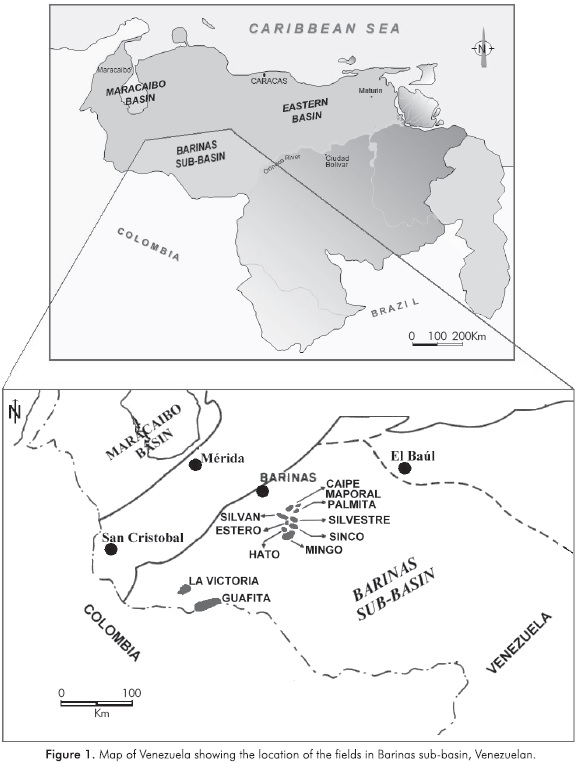 .
.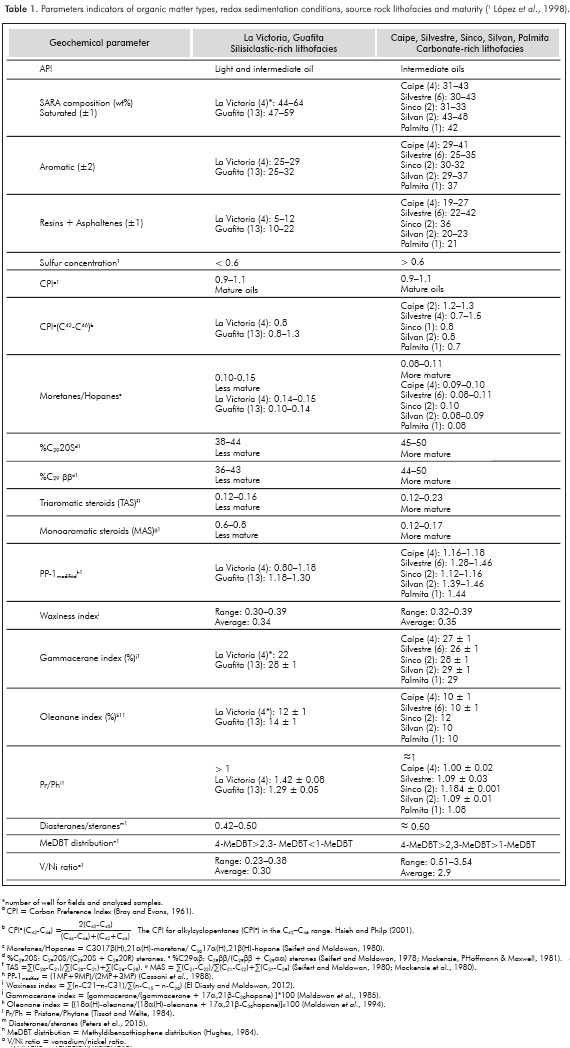 .
.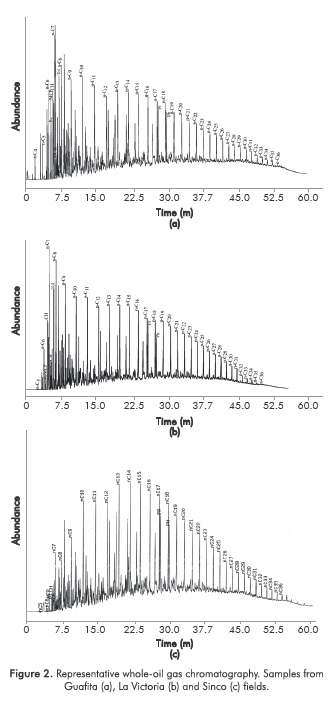 .
.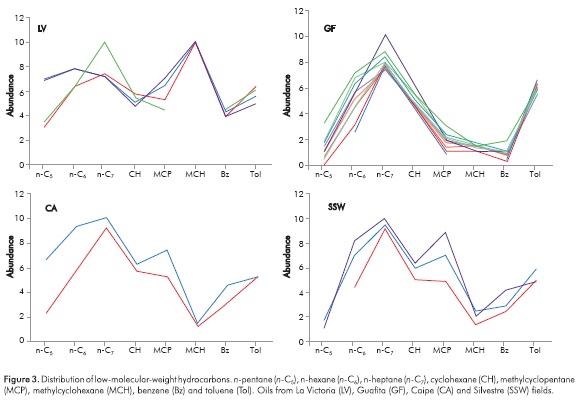 .
.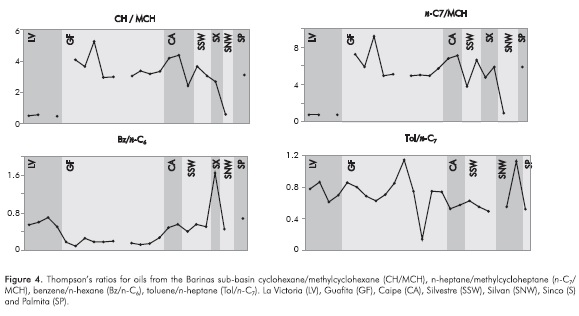 .
.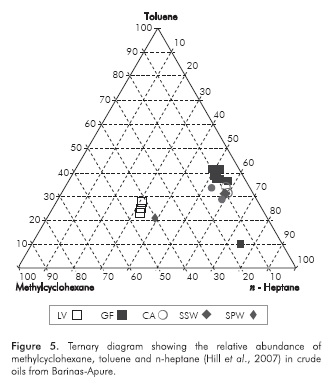 .
.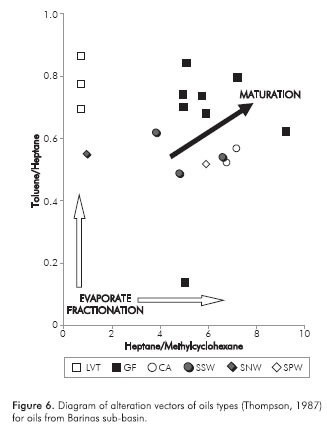 .
.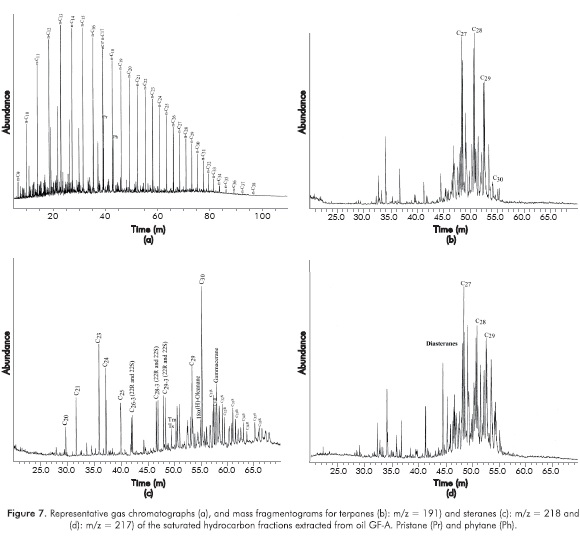 .
.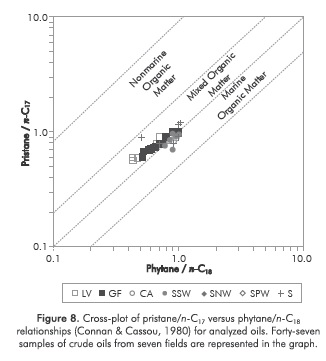 .
.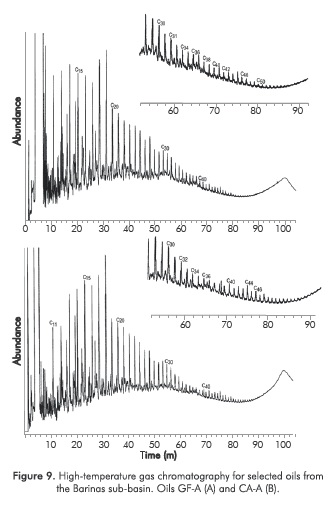 .
.